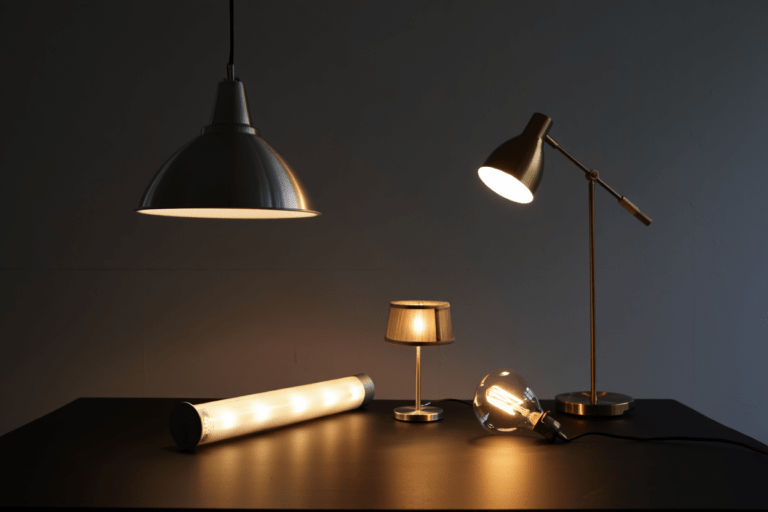Ultimate Guide to LED Lighting for Gyms
Table of Contents
The specific lighting demands of gyms and sports facilities often necessitate a diverse range of light fixtures to ensure comprehensive coverage. Conversations about gym lighting are infrequent, even among gym proprietors. These individuals occasionally seek insights into top-tier gym lighting and a broader selection of general lighting alternatives.
The introduction of LED (Light Emitting Diode) technology has revolutionized the lighting industry. Consequently, we now have various LED lighting choices in various categories. However, discerning the optimal LED gym lighting fixtures from this vast selection might pose a challenge.
In this comprehensive guide, we aim to illuminate the key features of different LED Gym lighting types to assist you in making an informed choice. We’ll also highlight the advantages and drawbacks of each LED Gym lighting variant, so let’s dive in!

Understanding LED Gym Lighting
Exploring gym lighting options, you’ll encounter numerous alternatives. LEDs are the most efficient and functional choice for illuminating gym spaces. LEDs, an acronym for Light Emitting Diodes, generate high-intensity illumination for indoor and outdoor settings. Despite their slightly higher initial cost, they offer the most economical lighting solution in the long run.
LEDs typically use 75% less energy than conventional bulbs and boast a significantly longer lifespan. An added advantage of LEDs is their conversion of most electric power directly into light, making them an exceedingly safe choice. Their low heat generation greatly reduces the potential for fire-related mishaps.
The Role of Lighting in Gyms
Lighting in a gym holds multifaceted importance. Let’s break it down into distinct categories.
1. Functionality
The primary role of lighting in any environment is to enhance functionality. This may seem straightforward, but achieving optimal lighting necessitates an understanding that different areas within a gym will require varying light levels. For instance, workout rooms need to be brightly lit to ensure the visibility of every piece of equipment, ideally as bright as natural daylight.
Conversely, spaces like locker rooms and showers don’t require as intense a light level. These areas can be appropriately lit with fixtures emitting a lower lumen output. The key is to identify the distinct purposes of each area and provide suitable illumination accordingly.
2. Ambiance and Aesthetics
Lighting significantly contributes to a place’s atmosphere, making it appealing and motivating for members to visit regularly. Dull lighting can result in a lackluster gym experience, potentially deterring members from returning. As a gym owner, this is detrimental to your business. Counteracting this issue involves installing vibrant, energizing lights that help create a dynamic and inviting environment. Understanding these elements will be expanded upon later in the guide.
3. Economic Efficiency
Lighting constitutes a substantial portion of a gym’s overall power consumption. You can reduce operational costs and enhance profit margins by implementing energy-efficient lighting solutions like LEDs. For instance, a gym using traditional incandescent bulbs typically has energy expenses 75% higher than a similar-sized gym employing LEDs. Therefore, a more economical lighting approach can free up funds for other productive aspects of the business, such as hiring professional trainers. These enhancements could potentially attract more gym members.
Use of LED Lighting in Different Sections of a Gym:
A fitness center comprises various areas, each with distinct lighting needs. Some key zones that require top-notch LED lighting solutions include:

- Entrance: The entryway, the most visible and critical exterior of the gym, can’t afford to have subpar lighting. Therefore, choosing a well-planned, brighter lighting solution is essential to draw attention.
- Main Exercise Areas: The exercise space is often the gym’s most crowded and active part. As it’s filled with people using different equipment and weights, the lighting should be sufficiently bright but not too harsh to cause reflections on the mirrors, which could disrupt workouts. Thus, a lighting solution with lower lumen output is perfect for these areas.
- Cardio and Warm-up Spaces: In the cardio and warm-up spaces, adequate lighting is a must. As cardio exercises and warm-ups form the initial part of a workout routine and aid in enhancing concentration, LED Linear high bay lights, a premier gym lighting choice, is ideal for such zones.
- Lockers: The locker area, where members store their items, requires bright lighting to ensure users’ security and ease of access.
- Restrooms and Shower Zones: The restrooms and shower areas are frequently visited by gym-goers post-workout. These zones require well-balanced lighting – neither bright nor dim – to maintain comfort and flexibility.
Varieties of Gym Lighting
An array of lighting options are available on the market to fulfill the lighting needs we’ve previously discussed. To make an informed choice for your fitness facility, it’s essential to comprehend the advantages and potential drawbacks of each type of lighting solution. Here’s an overview.
1. Incandescent Bulbs
Among the oldest types of lighting solutions, incandescent bulbs still hold a place in the market due to their premium pricing. They give off a yellow-toned light, with the intensity depending on the wattage. Higher-wattage bulbs produce brighter light at the expense of increased energy consumption. Furthermore, their shorter lifespan means more frequent replacement.
2. LEDs
LEDs represent the stark contrast to incandescent bulbs. They have a higher initial cost but are much more energy-efficient and have a longer lifespan. LEDs might be the way to go if you’re searching for a practical and long-term solution. Though the upfront cost might seem daunting, the long-term savings on energy bills will quickly offset this. Plus, their longevity means fewer replacements, adding to the convenience.
3. Fluorescent Lighting
Fluorescent lights offer a compromise between LEDs and incandescent bulbs. These use a low-pressure mercury-vapor-gas discharge to emit light, making them more durable than incandescent bulbs but less energy-efficient than LEDs. They’re often chosen for their balance of price and performance – cheaper than LEDs but more robust and efficient than incandescent bulbs. CFLs could be the answer if you seek a balanced solution that won’t break the bank.
Advantages of LED Lighting in a Gym
Now that you’re familiar with various lighting options and their respective uses let’s delve into why LEDs can be an optimal choice for your gym.
1. Top-Quality Lighting
LEDs offer an unmatched variety, making them perfect for gym spaces. They come in various types, sizes, shapes, color temperatures, and color rendering indexes, allowing you to tailor the illumination to each area’s specific needs.
Different gym zones – such as workout areas, showers, lockers, and cardio zones – can benefit from different LED lights. LEDs also come in diverse designs, from lantern-style fixtures to linear tubes, offering the flexibility to get creative with your gym’s aesthetic. This well-curated lighting can attract more members to your facility.
2. Glare-Free Illumination
The primary advantages of LED lights include their non-glaring properties, making them ideal for gym environments. Preventing sudden, blinding light interruptions during workouts, like deadlifts, is critical for avoiding undesirable accidents. The use of LEDs virtually eliminates this safety concern. Anti-glare LEDs elevate this safety aspect even further.
LEDs are also notable for their minimal heat emission due to their efficiency in converting electricity to light. As a result, even when fitted in confined spaces, LEDs pose no harm to those navigating such areas.
3. Cost Efficiency
LEDs have the benefit of being energy efficient, consuming minimal power compared to other light sources. Employing LEDs in your gym can considerably reduce your energy costs. The savings could then be channeled into more productive areas, such as procuring new equipment or expanding your staff. Additionally, lower running costs could enable competitive membership pricing, thereby boosting gym membership and, in turn, increasing profits.
4. Longevity
The durability of lighting is a crucial yet often neglected factor when illuminating a gym. It is essential to prevent lighting malfunctions during gym use as it can lead to safety issues and negative customer perceptions. Furthermore, the inconvenience of having to replace light bulbs every few months can be avoided with LEDs. With their exceptional lifespan, LEDs ensure peace of mind for a long period post-installation. Good quality LEDs can last for years, ensuring minimal replacement requirements.
5. Enhancing Aesthetics
Aesthetic appeal can significantly influence gym patronage. A drab, uninspiring environment is hardly conducive to motivating gym-goers. A gym needs to be a space where members feel positive about themselves; the right lighting can contribute greatly. With the right mix of LED fixtures, you can create an uplifting atmosphere that keeps your members motivated.
key aspects Before Installing LED Lighting in a Gym

You’re likely to encounter several technical terms when considering LEDs for your gym. To choose the most fitting lighting solution, it’s important to understand these terms. Let’s delve into some key aspects before selecting a lighting fixture for your gym.
1. Color Temperature
The hue discharged by a specific LED is defined by its color temperature. This is gauged on a Kelvin scale, stretching from 1,000K to 10,000 K. LEDs towards the lower end of the spectrum radiate warm light, thus generating a comfy ambiance. While welcoming, this warm atmosphere isn’t ideal for a gym, as it encourages relaxation rather than activity. For a more stimulating effect, opt for LEDs that surpass the 4,000K mark. These LEDs exude a cool light akin to natural daylight, making gym-goers feel more energetic.
That being said, not all areas in the gym call for high color temperatures. Areas like the locker rooms and showers can make do with LEDs operating below 4,000K.
2. Lumens
Lumens are a measure of light intensity. An LED with more lumens will cast brighter light, illuminating a larger area. Calculating a gym’s total lumen requirements and distributing this total across several fixtures is a smart strategy. Typically, gyms necessitate around 20 lumens per square foot. Determine the total lumen requirements by multiplying the gym’s square footage by 20. However, remember that this figure pertains to workout zones; the locker and shower rooms can be lit with lower lumens.
3. Sensors
Certain gym areas require constant illumination, whereas others are used sporadically. For the latter, consider investing in smart lights equipped with sensors. These lights self-regulate, turning on and off based on the area’s usage, which can lead to significant energy savings. Smart lights often come with nifty remote control options along with motion detection. With a simple tap on your phone or a dedicated remote, you can modify the color, temperature, and brightness, creating varying atmospheres in the same space.
4. Fixture Designs
Beyond color temperatures and CRIs, LEDs also come in many designs. Different fixtures disperse light in unique ways. For instance, a spotlight focuses the light beam on a specific area, whereas a floodlight disperses it over a broader region. When choosing fixtures for your gym, consider their design and purpose.
In essence, a well-lit gym should have three types of lighting: accent, ambient, and decorative. Seek fixtures that cater to these specific needs, and you’ll achieve a well-balanced lighting design.

Guidelines for Planning Your LED Gym Lighting Layout
By this point, you should be familiar with LED lighting fundamentals. Although little can go wrong from here, this section will help you to refine even the minutest details to perfection. Let’s delve into the method for correctly illuminating your gym.
Step 1: Calculate Your Gym’s Area
To determine the lumens your gym needs, you’ll need to calculate its area in square feet. After determining the total area, multiply this by 20 to find the total lumens your space requires. This lumens calculation will inform you of the fixtures your gym needs.
Step 2: Ensuring Sufficient Spacing
Having enough space between fixtures is crucial to achieve a uniformly lit environment. For spaces with ceiling heights ranging from 15-18 feet, fixtures should be positioned at least 20 ft apart. For areas with ceilings of 30 feet or higher, fixtures should be spaced 20 to 25 feet apart.
Step 3: Position Your Lights Thoughtfully
The distances mentioned above are a general guideline and can be modified according to your desired layout. For instance, if you wish for one area to be more illuminated, you can position fixtures closer together. The takeaway is to have a well-thought-out plan before initiating the lighting process.
Conclusion
The advantages of adequately lighting a gym are numerous, extending beyond just improving its functionality. It plays a significant role in enhancing aesthetics, creating an energetic ambiance, and lowering operating expenses. The right lighting solutions are essential to achieve this, with LEDs being the ideal choice. However, while employing LEDs, it’s important to consider several factors. We trust that this guide has provided useful insights.
MyLikeLed is a trusted manufacturer of high-quality LED strips and LED neon flex. All our products undergo rigorous quality checks in high-tech laboratories. Additionally, we offer customization options for our LED strips and neon flex. Contact MyLikeLed today for top-quality LED strip and LED neon flex solutions!
FAQs
LED lighting improves the gym experience by creating a brighter, more inviting atmosphere. It also reduces eye strain and shadows, making workouts feel more comfortable and motivating.
Yes, LED lighting is safe for gyms. LEDs don’t get hot like traditional bulbs and are free from harmful UV rays, making them safe for both equipment and people.
Absolutely. LED lights use up to 75% less energy than traditional lighting, which significantly lowers monthly electricity costs for gyms.
A color temperature between 4000K to 5000K is best. This provides a bright, natural white light that boosts energy and visibility, perfect for fitness settings.
Yes, LED lights can be installed in most existing setups. There are retrofit options available that fit into current fixtures, making upgrades simple and cost-effective.

Hi, I’m Xylia Xiong, a sales professional with 14 years of experience in the LED strip light industry. I specialize in providing tailored solutions, leveraging my expertise in LED products and the latest industry trends. Known for effective communication and problem-solving, I’m dedicated to helping lighting manufacturers, importers, and distributors achieve their goals.
Let’s work together to create customized solutions that exceed expectations.
Related Posts


Soft white Vs daylight: What Should You Choose?

Types Of Lighting And Their Applications – Expert Guide

- Call Us: +86-15920391130
- Email: info@mylikeled.com
- Office Address: No. 4 Keying road, Beitai road, Baiyun district, Guangzhou, China
- Factory: Building 12, Liandong U Valley, Guangqing Industrial Park, Shijiao Town, Qingcheng District, Qingyuan City, Guangdong, China
Copyright © 2025 – My Like Led All rights reserved.

